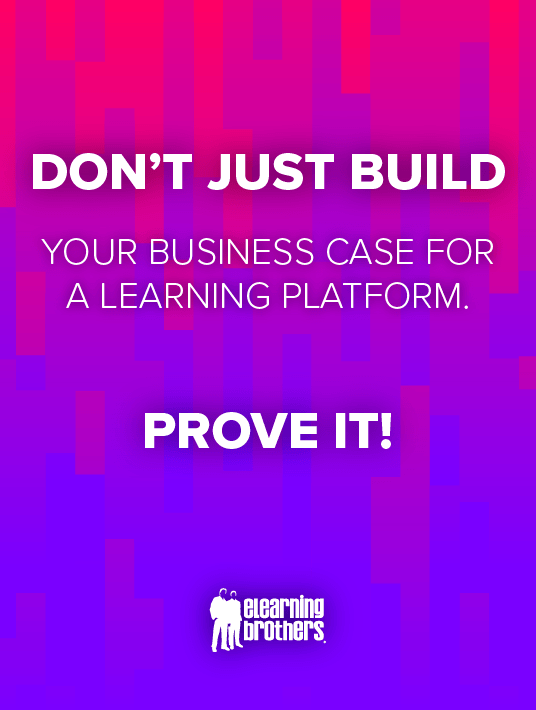Plan Your New Learning Platform Proof Of Concept In Four Steps
In our previous article we shared steps leading up to the Proof of Concept (POC) and challenges you may have to overcome when buying and implementing a new learning platform. With these things in mind, you’re ready to plan your POC. This involves:
- Choosing your focus (target use cases)
- Specifying objectives
- Defining success criteria
- Drawing out a timeline and milestones

1. Choose Your Focus (Target Use Cases)
The first step is to choose your focus by identifying 1 to 3 target use cases. Choosing your focus goes back, primarily, to the questions: “What problem are you trying to solve?” or “What opportunity would you like to take advantage of?” This is your justification for proposing to buy a learning platform in the first place.
Let’s look at four common use cases you might choose to focus on.
1. Virtual Onboarding
Many organizations are finding they need a virtual onboarding program. Hiring new employees in our mostly work from home (WFH) environment presents unique challenges for the onboarding process, which may include:
- Pre-hire skills assessment
- Certification or licensing
- New hire orientation of policies, process, and culture
- Initial and ongoing compliance and regulatory training, sexual harassment and diversity training, safety training, continuing education credit, re-certification, and skills training
Effective onboarding also includes sharing your company culture and values with new employees. If virtual onboarding is your focus, you might be interested in learning platforms that provide some type of immersive content like a welcome video or a virtual office tour, in addition to the ability to deliver and track the completion of required training modules.
2. Transitioning From a Live Classroom to Virtual Meeting
Across the industry, we’re seeing a forced transition from classroom-based training to virtual face-to-face or online digital learning. Former classroom trainers are now becoming online learning facilitators and are going through the process of converting classroom learning materials to online materials and figuring out new ways to engage learners and assess competency. One key piece of functionality you might look for in this case is the ability for learners to upload evidence of demonstrated skills.
3. Retaining Top Talent
Many organizations implement a learning platform as part of an initiative to recruit and retain top talent by providing opportunities for professional development and individual growth. You may already have a system to deliver mandatory compliance, regulatory, and safety training, but it may not be possible with that system to include opportunities for self-directed learning in pursuit of individual professional interests.
In this case, you should look for a learning experience platform that includes an off-the-shelf course library for soft skills development, upskilling, reskilling, or cross-training. Another consideration is learner communities and the sharing of knowledge between learners. For some employees, sharing knowledge and promoting the learning, growth, and performance of others in the learning community can be a source of satisfaction and motivation.
4. Implementing a New Learning Paradigm
Do you need to make a learning paradigm change? Perhaps your focus is on transitioning from instructor-led, binder-based, or interactive Flash-based training to video-based mobile learning. If this is what you’re after, you’ll want to validate the process for creating, delivering, and experiencing video-based training in the learning platform you’ve selected.
2. Specify Objectives
The next step is to specify objectives for each of your target use cases. As an example, let’s look at possible objectives for each of the four target use case examples described above.
1. Virtual Onboarding
How do you create a meaningful and effective experience for bringing new employees into your organization when everyone is working from home? That’s a question many organizations are asking themselves. If this is your use case, your virtual onboarding POC might include these specific objectives:
- Posting a welcome video into an onboarding learning track facilitated by the learning platform
- Providing a virtual office tour.
Alternatively, or maybe in addition to that, you might have a use case for safety training (remember though, you want to focus on one to three use cases, max, per team). The objectives for this use case could include:
- Adding a Fire Safety course to the learning platform
- Enrolling learners in the course
- Having learners take and complete the training
Don’t forget to consider where you’re sourcing this training from. The Fire Safety course may be one that you’ve created, one that you’ve licensed, or one that’s part of the off-the-shelf course library of the learning platform you’re working with. Enrolling users might be a manual process, an automated process, or a batch upload. When you look at tracking user completion of the training, you’ll want to consider the ability to report on individual users and all users. Considering these details as you’re thinking them through will help you define your specific objectives.
2. Retaining Top Talent
If you’re looking to increase employee satisfaction and reduce turnover in your organization, your use case might be to retain top talent. One part of your strategy for doing this might include providing employees opportunities for self-directed learning, professional development, and individual growth. Objectives for your talent retention use case might include:
- Demonstrating learner ability to browse and search the learning platform’s integrated course library
- Demonstrating learner ability to mark courses as favorites or self-enroll
- Tracking and monitoring the topics and skills your employees are most interested in
- Demonstrating automated learner email notifications and reminders
3. Implementing a New Learning Paradigm
If your organization has a long history of instructor-led, binder-based, or interactive Flash-based training, you may be looking to transform that into video-based learning that can happen on a desktop or mobile device. Your use case would be video-based training, and your objectives might be:
- Upload a 5-minute training video
- Add an interactive viewing guide for the learner to better follow along with and engage with the video
- Demonstrate learner ability to upload a picture or video of their own to demonstrate their ability to complete the skill being taught
- Review, as a facilitator or coach, the learner’s completed viewing guide and submitted evidence
Aside from these typical examples, your organization may have other needs such as automating customer training, improving sales enablement, or personalizing compliance training to better identify skills gaps. A trusted vendor will be able to help you outline a solution.
3. Define Success Criteria
After you’ve chosen your focus by identifying key use cases and objectives, your next step is to define success criteria. Your definition of success, which is also your exit criteria for those use cases in the POC, might be as simple as, “Successful demonstration in the learning platform of all objectives.” Other ways to define success might include specific criteria, for example:
- “Employees are able to search for, and enroll, in courses of interest.”
- “Customer Support Representatives are able to provide accurate information regarding the functionality of new feature X.”
- “Sales representatives successfully demonstrate feature X, including 3 key value statements and solicitation of a response from the prospect regarding how they could see themselves using this feature in their organization.”
One of the factors that makes the Rockstar Learning Proof-of-Concept Model™ approach so powerful is that it enables you to demonstrate real value by showing how the digital learning platform solves a fundamental problem for your organization. In the last example above, this value is demonstrated by delivering product training for your sales representatives and using the digital learning platform to facilitate coaching to connect value with real customer needs during product feature demos.
4. Layout Your Timeline and Milestones
The last step in planning your proof of concept is to define milestones with start dates, end dates, and a schedule of your planned objectives for each milestone. Each one of the stakeholder groups participating in the POC should have objectives scheduled in each milestone. We recommend that you have no more than 4 milestones and that each milestone be no more than one to two weeks long.
More Insider Secrets To Plan Your Proof Of Concept
Looking for tips to execute your Proof Of Concept and make a successful business case? Download the eBook Don't Just Build Your Business Case For A Learning Platform. Prove It! to learn more about conducting a proofing on concept and getting stakeholder buy-in.









